- Home
- Aaron Allston
Terminator 3--Terminator Hunt Page 11
Terminator 3--Terminator Hunt Read online
Page 11
“Debrief now, smirk later,” Sato said. “So?”
“So he tells her everything. He’s a lonely old man and she’s the only one he opens up to.”
“And where does he talk to her?” Sato asked. The deal passed to Smart; Sato accepted his cards and looked at them. It was a worthless hand, but three of the cards were hearts and suggested the distant possibility of a flush.
J. L thought about it and looked a little bothered. “I don’t know.”
Jenna gave Sato a scornful look. “Well, in his bedroom or hers, of course.”
J. L. shook his head. “No, it wouldn’t be. Mears has this ethic about personal privacy. Her bedroom is her private place; he never visits her there. And the same for his. No one goes there but him.”
Sato anted up and accepted two new cards. “So where do they get together?”
“I said I don’t know.”
“That wasn’t so much a question as an oblique reference to tomorrow’s assignment.” With all cards in and bets down, Sato dropped his hand on the table, five hearts. “Boss goes on another shooting spree.”
Nix sighed, exasperated. “It’s going to be one of those nights.”
Sangre de Cristo Mountains, New Mexico
Nearly two hundred miles south of Clover Compound, a convoy of military vehicles wound its way along the roads of the Sangre de Cristo Mountains. Many miles to the south, the mountains petered out near Santa Fe, but here they were in full command of the earth. And like the Rockies and every other mountain range, they were a comfort to the men and women of the Resistance, their juniper-covered ridges and folds offering many places to hide, places from which to fight.
The first and last vehicles were SUVs carrying members of the Hell-Hounds. Second and fourth were old Army trucks, the one that had left Home Plate with the convoy and another that the procession had picked up in a Resistance compound within Las Vegas. In the middle was John Connor’s Humvee. Each vehicle was at least a half-mile in advance of the others, making it harder for Skynet’s satellites to pick up a tell-tale concentration of infrared blips, harder for Skynet’s forces to ambush one vehicle and wipe out the entire convoy.
“It’s empty, though,” said the man in the backseat. He had the driver’s-side window, with Kate Brewster at the passenger-side window and John Connor in the middle. In the front seat, Glitch, the Hell-Hounds’ T-850, drove, while Sgt. Fred Ginty, technician and relief driver, napped in the passenger seat.
The speaker continued, “We’ve been all through that armory, didn’t leave a nail or a tin washer.” He was short and dark, his skin as leathery as if it had sat out under the sun since J-Day and occasionally received a bit of saddle soap. On his chest, only slightly concealed by his vest, was a grayish tattoo of the silhouette of a Hunter-Killer, one of Skynet’s aerial units. His name was Ed Piñon, and he was a full-blooded Mescalero Apache from south of these parts. A scout from Lance Compound, one of the Mescalero strongholds, Piñon was supposed to know these mountains like the veins and scars of his own hand, and it was only reluctantly that his compound leader had offered his services to John and Kate.
“I doubt we’ll be disappointed, even if it’s empty,” John said. “I mean, hell, it’s lovely weather to be a tourist.”
“And it’s been forever since we’ve seen New Mexico,” Kate added.
Piñon snorted. “Whatever. At least we don’t get much Skynet activity out here. Say.” He gestured at Glitch. “This is really a T, right? Do you ever just stand around beating on it, to burn off hard feelings?”
John shook his head. “Now, think about that. Teach people that they can casually slap a Terminator around and they’ll what?”
“Well, they’ll slap a Terminator around.” Then Piñon considered. “And they’ll lose some of their fear of the things.”
“That’s right. So we program Glitch and any others we capture to have some self-preservative behavior, even when it concerns Resistance humans. Slap him around and he probably won’t do much more than break your fingers.”
“But it will be done for maximum pain,” Glitch said. Those were his first words in about two hundred miles.
“Oh, well.” Piñon sat back.
An hour later they made the final turnoff onto the paved, one-lane government road that would take them to the armory. The road was in good condition, not at all potholed or crumbling after years of disuse.
That sort of thing had surprised John and Kate in the early years after Judgment Day. They’d always assumed that with no crews to maintain them, the roads would weather and deteriorate. But except for areas of extreme heat, hot enough to melt asphalt, or cold and precipitation, where the ravages of ice could not be avoided, the roads tended to endure in much the same condition they were in when the traffic ended. This was a boon to the Resistance. Skynet couldn’t afford to damage main highway arteries to inconvenience the Resistance; the machines used those roads themselves. Nor could Skynet destroy all of America’s back roads; there were simply too many. So the roads remained, mute testimony to the engineering skills of the species that once ruled the Earth.
This road took them up over and between hills, along trenches cut through hillsides by construction equipment that now lay in distant, rusty graves. John noted untended fields of beans and corn, some of it growing as tall and healthy as it had before J-Day. With the scent of juniper surrounding him, he could pretend for just a moment that this was a ride in the country in a world where cars roared endlessly along city streets, where TVs showed sitcoms and soap operas, where people packed dance halls and had nothing on their minds more weighty than making a connection for the evening or scraping up the rent to mail off tomorrow morning.
Beside him, Kate had her arm along the door window, her chin resting on her forearm. Her expression, untroubled and contemplative, matched his mood.
They rounded a final turn and drove through the already-open gate of a chain-link fence. Its corroded sign marked the land beyond as U.S. government property and warned of serious consequences for trespassing. Not far beyond was a security booth, its glass long since broken, and beyond that, its rear end nestling against a low, round-topped hill, was the building.
It was shaped like a capital T, with the crossbar lying flush against the hillside and its main bar pointed straight at John’s Humvee, straight at the entrance into this small compound. The entire building had a curved roof, like two oversized Quonset huts or extended airplane hangar, making it about a story-and-a half tall at its edges and about two stories tall at the top of the roof. Its walls were made of crumbling adobe instead of corrugated metal, the untended irregularity of the flaking surface making it look as though the entire building needed a shave. John fingered the three days’ worth of stubble that surrounded his own beard.
The building was surrounded on three sides by parking lot. Without instruction, Glitch angled around to the left. As that wall came into view, so did the vehicle-sized doors there; they were already open. Glitch guided the Humvee through, into the darkened interior.
The dirt-brown SUV of the Hell-Hounds, which had carried Ten and Earl, was parked within, as was the Army truck they’d picked up in Las Vegas. The crews and passengers of the two vehicles were walking around, stretching their legs in the cavernously empty building interior. When Glitch killed the Humvee’s engine, John could hear the steps of their bootheels echoing from the concrete floor and walls.
As the Humvee’s occupants exited their vehicle, Piñon gestured around. “We sometimes use it as a temporary shelter on long courier runs. Mostly we stay in the smaller rooms of the other wing. But the place doesn’t afford much of a view of the countryside, and it’s not very defensible. Not a good place to stay. And, like I said, it’s been stripped. We finished what the National Guard started.”
John nodded and looked around. He caught Ten’s eye. “Tom’s in the other truck, correct?”
Ten nodded.
“Any word from your second vehicle?” That would be the Hel
l-Hounds’ other SUV, the dark green one, which carried Kyla and Mark.
“No word,” Ten said.
That was good. In a world where radio silence was the normal state of affairs, no news tended to be good news.
The second truck pulled in four minutes later. Steam curled up from beneath its hood, and the instant it stopped technicians piled out from the back and swarmed around the engine. Paul Keeley emerged from the back, set his pack down well away from the others, and sat down to do some stretching exercises. Next out was Tom Carter.
John and Kate waited until the technician had walked a little stiffness from his legs, then joined him. “Time for the acid test,” Kate said.
The three of them headed toward the hall’s back wall. Suspicious, Piñon trotted up and joined them. “What acid test?” Then, remembering he was addressing the Resistance leader, added, “Sir?”
“Old intelligence,” John said. They reached the back wall and walked along it, scrutinizing it for clues pointing to what they were looking for. Unlike the front and side walls, this surface was metal, covered with a peeling layer of paint. “Before J-Day, a far-sighted fellow who anticipated Skynet’s rise erased this place from computerized government records. Wiped out all record of the place itself and of its special function. We learned about it a few weeks ago.”
That was only a fraction of the story. That “far-sighted fellow,” Daniel Ávila, had repeated that effort for dozens of caches, abandoned silos, and cave systems across the spectrum of U.S. Department of Defense records. In the last month, the Resistance had located and entered two of those sites, which could now serve as habitats and weapon caches.
But as spread out and undermanned as it was, the Resistance could only absorb so many such treasure troves at any one time. Opening several all at once increased the odds of Skynet detecting their activities. Telling someone outside Connor’s immediate circle of advisers also increased that risk, which was one reason Piñon was only to receive a fraction of the story.
They reached the end of the metal wall. It turned to painted cinder blocks for a foot or so, then met the side wall into which was set a plain wooden door leading into the side wing.
Above the door was an air-conditioning vent, too small to accommodate any living thing larger than a cat. Carter looked at it and said, “I need up.”
Glitch approached. Without preamble, he seized Carter by the belt and straight-armed him upward.
Carter put one boot against the wall and another back against Glitch’s chin to brace himself, then got to work on the vent grill with a screwdriver. A moment later, he dropped the grill onto the floor; the sound of the metal meeting concrete was shrill, causing silence-loving Resistance members to jump.
Carter reached into the vent and went to work on something within. “Back in the day,” he said, “this could have been accomplished with a remote control—if they upgraded it in time, even with a cell phone. But we’re now off any operating power grid, and I doubt the backup generators will even function without an overhaul. This leaves the possibility…” There was a quiet clank, and then Carter discarded another metal plate, this one almost featureless, bearing only four corner holes for screws. Kate caught it on the way down. “The possibility that capacitance charges will still work. They built these babies tough—and usually with multiple redundancy.”
John took a side look at Piñon. Realization was dawning on the man’s face. “There’s a second installation here,” Piñon said.
Kate nodded. “Uh-huh.”
“But it’s got to be empty, too.”
“Possible,” John said. “But we have to remember that what we had here was a two-level organization. The National Guard operated the armory, and unknown to everyone except the armory’s most senior officers, there was also a skeleton crew maintaining the additional vehicles here. They would have looked and dressed like National Guard personnel, but would have actually belonged to the DOD. When Judgment Day came, since the existence of this place had already been scraped out of the official records, odds are that its personnel would not have been sent orders about the disposition of whatever was here.”
There was the sound of an engine, but not from behind the wall. John and Kate turned to see the last convoy vehicle, the SUV carrying Mark Herrera and their daughter, pull into the building.
“Got it,” Carter said.
There was a sudden hum of noise, accompanied by a loud ratcheting, and the back wall sank into the floor. It settled with a substantial thump, revealing an opening as large as the metal portion of the wall had been.
Beyond were smooth concrete floor and natural stone ceiling, a cave that had been paved. After a few dozen steps, the floor descended as a ramp at an easy angle into the hillside.
And on the floor were vehicles—wheeled vehicles, tracked vehicles, vehicles John Connor had never seen before and could not name.
* * *
Paul joined the crowd of people who moved like vista-struck tourists into the depths of the vehicle cache. As he passed vehicle after vehicle, he named them, demonstrating one of the skills that had once made him valuable to the Resistance. “M109A5 Paladin 155-millimeter self-propelled howitzer,” he said. “One, two, three AM General High-Mobility Multipurpose Wheeled Vehicles—”
“Those are just Humvees,” Kyla said into his ear.
Paul ignored her. “Two equipped with Stinger air defense systems, making them Avengers.” Those two did not have rear seats or payload beds; instead, mounted in the backs were large, pivoting T-shaped apparati with maneuverable boxes at the ends. Each box held four Stinger missiles.
Paul passed them in a sort of reverent daze and pointed to the next vehicle in line. “Toyota Seven-Series Boxcar forklift.” That put him to the end of the first holding area for vehicles. He started down the ramp; in the distance, he could see the bobbing flashlight beams of those who had gone on ahead and the vehicles they illuminated. “M102 lightweight towed howitzer.” Several beams of light had come to rest on a white automobile-sized apparatus with treads, chain guns for arms, and a metal head shaped like a point-down triangle. “T-1 series Terminator.” He rushed toward it.
* * *
By afternoon’s end, John’s workers had erased all external signs that anyone had made an intrusion into this facility, including closing the hurricane fence gate and closing the armory’s external doors. They had also performed a preliminary inventory of the goods found in the hidden portion of the complex.
There had been more vehicles, of course. Trucks and motorcycles and staff cars, pickups with elaborate tool sets where the beds should be, an ambulance, and a short fire truck. There had been stockpiles of ammunition, including some surviving Stinger missiles and some very sophisticated shells for use with the self-propelled howitzer … though, sadly for the Resistance, there had been none of the nuclear missiles the howitzer could fire. There had been portable generators and a main generator for the complex that Tom Carter said was reparable. There had been stockpiles of food, uniforms, small arms.
The T-1 Terminator, though it attracted the attention of the Resistance technicians more than any other item here, wasn’t all that helpful a find. John wanted it returned to Home Plate intact as a museum piece for the future. It could, he supposed, be programmed for the defense of a habitat, but the T-1 was no match for a later model or for a well-trained team of humans. Glitch and a rocket-propelled grenade would have little trouble destroying it. Instead, its chain guns would be removed and set up for the defense of some compound, but the main unit would be preserved as a reminder for future generations.
For the Resistance, the complex’s contents constituted an unbelievable haul. Even when its goods were distributed among many of North America’s human compounds, what was left behind would continue to be of great use to the Resistance, as this place, once it had been adapted to modern techniques of concealed continuous living, could become a new habitat.
John’s technicians were now hard at work doing preliminar
y evaluations of the vehicles. Much of the rubber and plastics of tires, hoses, and belts was decayed to the point of uselessness and would have to be replaced on a jury-rigged or permanent basis before they could even think about moving vehicles out. Batteries were all drained and in many cases corroded beyond repair. But the early reports had been good. Within days, many of these vehicles would be patched up, filled with fuels brought in drums on Connor’s trucks, and dispatched for distant habitats. Once they reached their new homes, many of them would be converted to new power sources, including fuel cells scavenged from Skynet vehicles and Resistance-built hydrogen fuel cells.
John pretended to be mildly pleased. He and Kate moved from vehicle to vehicle and group to group, asking questions, offering encouragement, but making it appear as though this cache was exactly as expected. It wouldn’t do to have the leaders of the Resistance running around in circles, howling like hyperactive teenagers.
John stepped in beside Tom Carter as the man made a final walk of the portions of the complex that housed the vehicles. Behind them, Glitch, operating a huge hand crank meant for a team of men, slowly raised the concealing metal door to its closed position. Carter was sufficiently engrossed in the information on the clipboard he held that he took no notice of John joining him.
“Question,” John said.
Carter didn’t look up. He stumbled as they reached the lip of the ramp, but managed not to fall. “Shoot.”
“How’s your boy Keeley doing?”
Finally Carter did look up, considering. “Beats the hell out of me.”
“Well, you’ve been watching him—”
“Ever since we left Home Plate.” Carter shrugged expressively. “I only thought he was closed up before when I worked with him. Now he’s a blank wall. No graffiti on it to give me a clue what he’s thinking. This suggests to me that he hasn’t been programmed to infiltrate us. If he had been, he’d be integrating himself, ingratiating himself better. I don’t think he’s a traitor. I just think he’s a mess.”

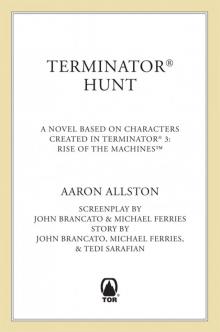 Terminator 3--Terminator Hunt
Terminator 3--Terminator Hunt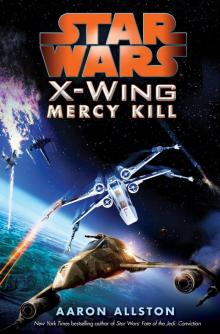 Mercy Kil
Mercy Kil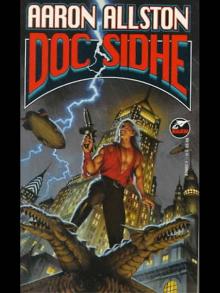 Doc Sidhe
Doc Sidhe Star Wars: Fate of the Jedi: Outcast
Star Wars: Fate of the Jedi: Outcast Fate of the Jedi: Backlash
Fate of the Jedi: Backlash Mercy Kill
Mercy Kill Rebel Stand
Rebel Stand Wraith Squadron
Wraith Squadron Star Wars: X-Wing VII: Solo Command
Star Wars: X-Wing VII: Solo Command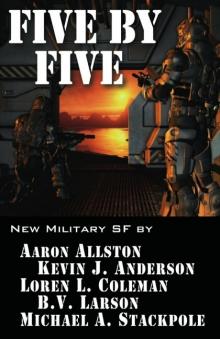 Five by Five
Five by Five Solo Command
Solo Command Star Wars: The Clone Wars Short Stories: The League of Spies
Star Wars: The Clone Wars Short Stories: The League of Spies Sidhe-Devil
Sidhe-Devil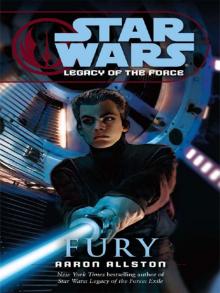 Star Wars: Legacy of the Force: Fury
Star Wars: Legacy of the Force: Fury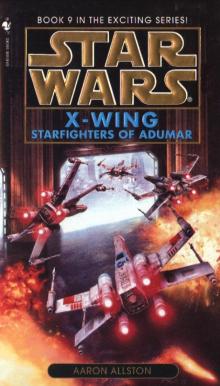 Starfighters of Adumar
Starfighters of Adumar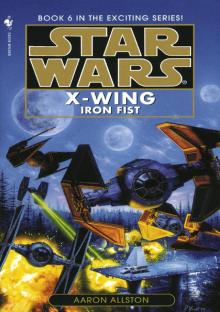 Star Wars: X-Wing VI: Iron Fist
Star Wars: X-Wing VI: Iron Fist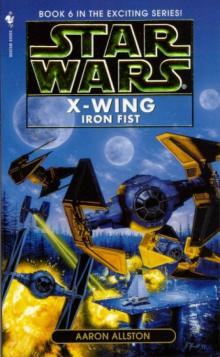 Star Wars - X-Wing - Iron Fist
Star Wars - X-Wing - Iron Fist Exile
Exile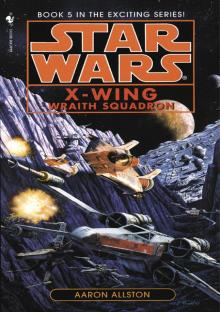 Star Wars: X-Wing V: Wraith Squadron
Star Wars: X-Wing V: Wraith Squadron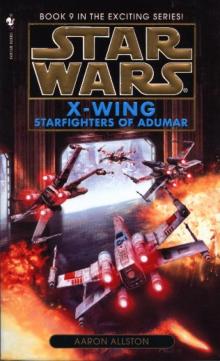 Star Wars - X-Wing - Starfighters of Adumar
Star Wars - X-Wing - Starfighters of Adumar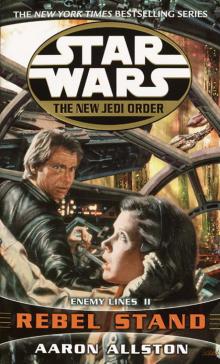 Rebel Stand: Enemy Lines II
Rebel Stand: Enemy Lines II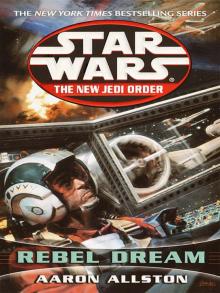 Rebel Dream: Enemy Lines I
Rebel Dream: Enemy Lines I Outcast
Outcast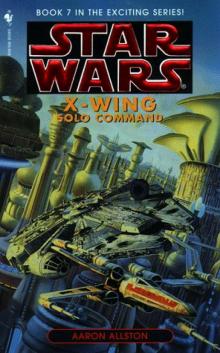 Star Wars - X-Wing 07 - Solo Command
Star Wars - X-Wing 07 - Solo Command